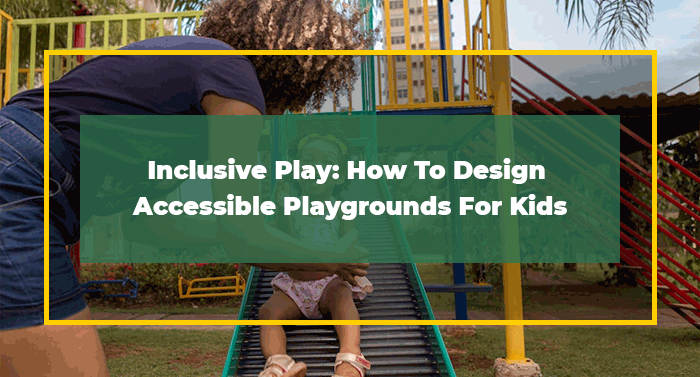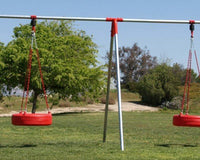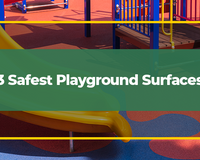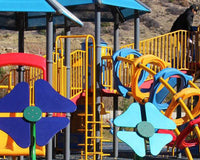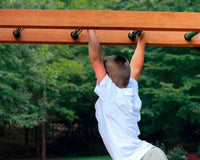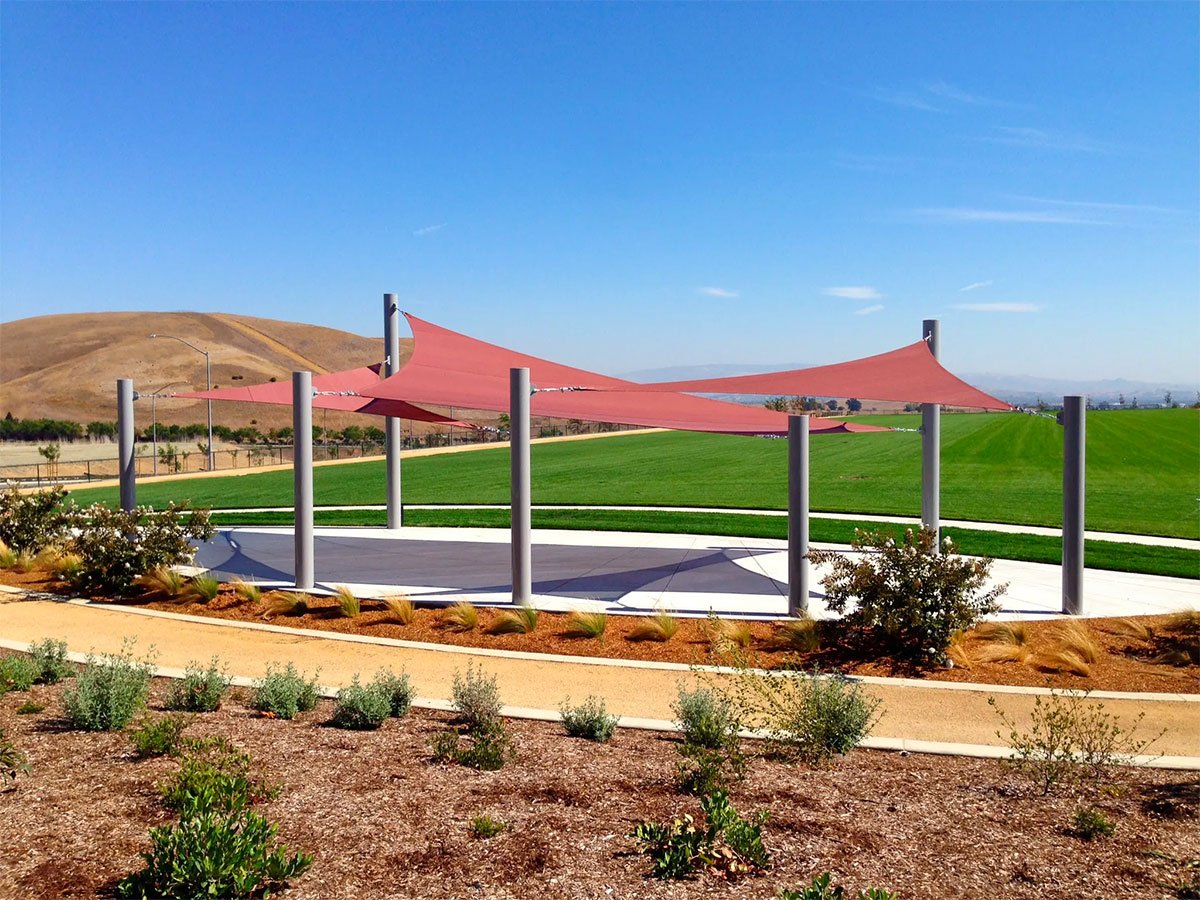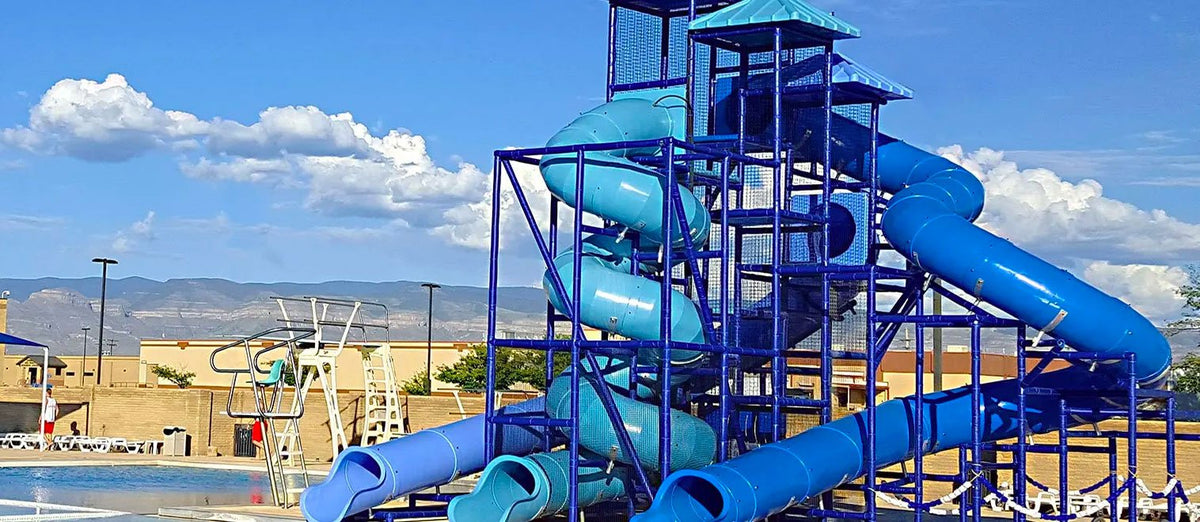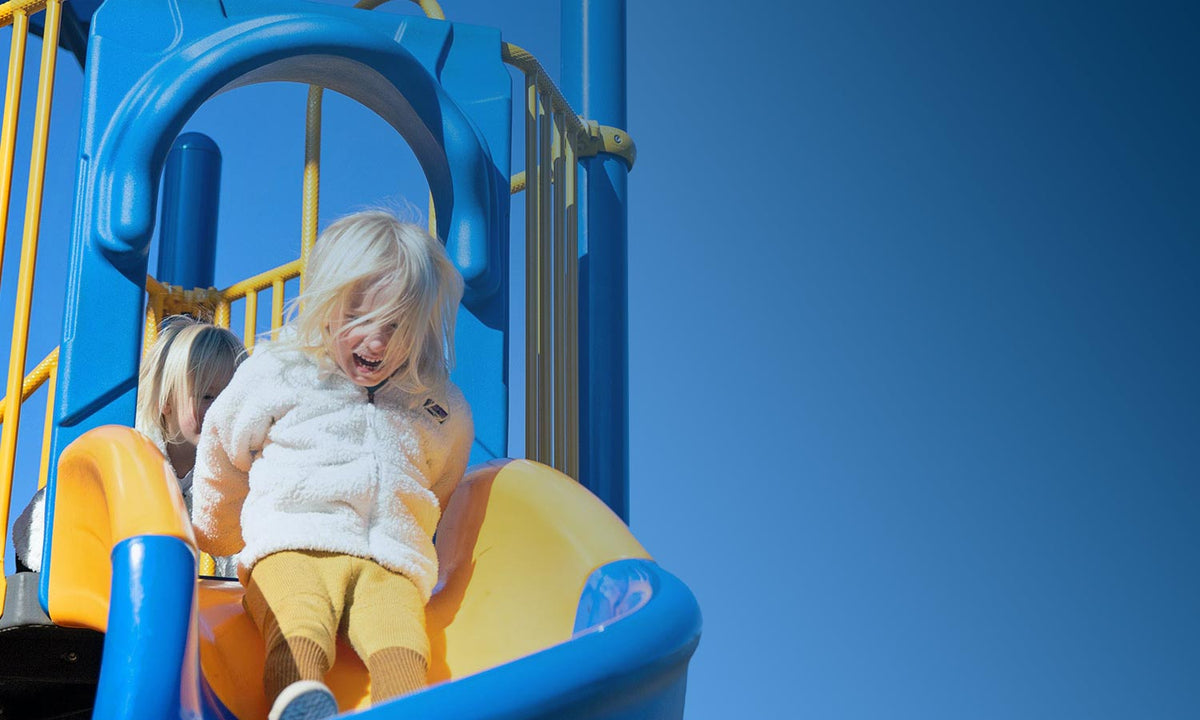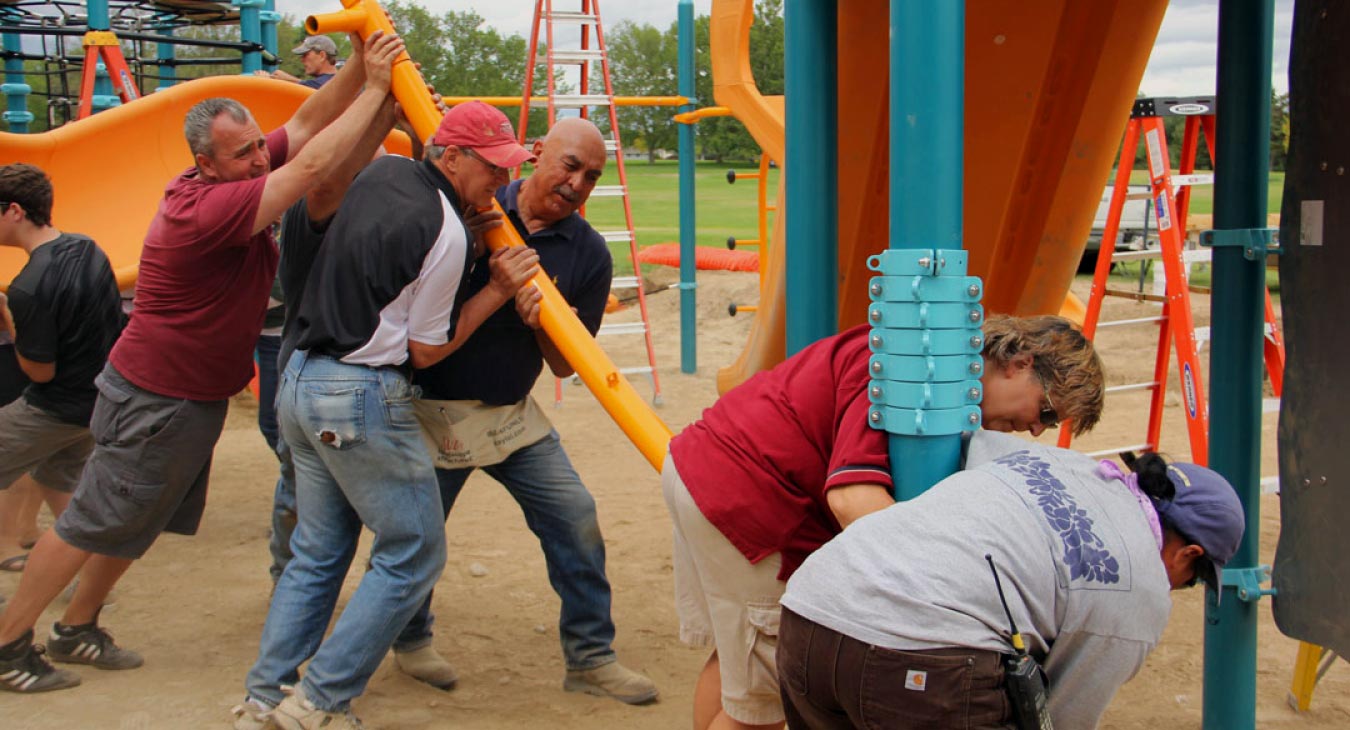Playing in playgrounds is a cherished part of childhood that’s also vital for a child's mental and physical development. Unfortunately, differently-abled children may not have the chance to experience this joy, especially with peers.
Inclusive and accessible playgrounds aim to rectify this by offering a safe, comfortable environment for children of all abilities and ages. These playgrounds are designed to cater to a range of needs, including those related to mobility and cognitive differences, ensuring that no child feels excluded.
Designing such playgrounds requires thoughtful consideration to merge accessibility and inclusivity seamlessly into the play experience. This guide will walk you through the essential principles and strategies for creating playgrounds that are welcoming and functional for both children and their caregivers.
Understanding Accessibility
Accessibility in playground design levels the playing field for children, rooted in intention and compliance with legal standards.
What Makes a Playground Accessible?
Accessibility in playground design reflects these elements:
- Recognizes diversity of disability. To ensure a playground is welcoming and enjoyable for everyone, regardless of ability, it must cater to both physical and mental impairments as defined by the Americans with Disabilities Act (ADA). This is a key consideration in selecting play equipment (more on this below), as you’ll want many kids to be able to use it.
- Eliminates physical barriers. Research suggests that the design and layout of a playground significantly influence its accessibility. Central to creating an accessible playground is ensuring ease of access for all children, including those using wheelchairs or with physical or mobility disabilities. The design should facilitate unimpeded movement throughout the entire playground.
- Provides diverse play opportunities. In light of children’s varying physical, emotional, and cognitive needs, an accessible playground offers a variety of play equipment. These pieces of playground sets for all ages pave the way for physical activity, sensory play, imaginative play, group play, solo play, and other play experiences.
- Makes room for inclusive design. Accessible design removes physical barriers to the playground, and inclusive design lets children socialize and interact with each other. Playing with other children helps develop social skills as they learn to make friends, communicate, and express themselves.
- Encourages solo play. Designate areas in your playground where children can play on their own. Children have varied play styles; some may become easily overstimulated, while others might need breaks to recover after high-energy activities.
- Uses respectful language. It's important to use language carefully in written signs and verbal communication. Words that were once acceptable might now be viewed as insensitive. These guidelines offer a basic framework for respectful dialogue regarding people and their disabilities.
Legal Requirements and Standards

The ADA is the starting point for any discussion about accessibility in legal terms. The ADA Standards for Accessible Design embodies and sets out the requirements for creating buildings or facilities that are physically accessible to people with disabilities.
The 2010 Standards cover new construction and alterations on or after March 15, 2012. These standards state minimum requirements for a play area, defined as a portion of a site containing play components or those elements “intended to generate specific opportunities for play, socialization, or learning” constructed for children.
Here are key guidelines with respect to play areas for Title II, state and local government facilities, and Title III, public accommodations and commercial facilities:
- A play area must have accessible routes, as specified and where required. There will be one accessible route within the site from an accessible parking space/loading zone or public street to an accessible building or facility entrance.
- One accessible route will be located within the play area and connect the ground-level and elevated play components. Per the ADA’s standards, a component is ground-level if it can be approached and exited at the ground level, and elevated play components as those attached to a composite play structure and approachable from a platform or deck.
- For ground-level play components, at least one of each type is required to be on an accessible route. For elevated-play components, 50% should be on an accessible route.
- Soft-contained play structures must have one or two entry points on an accessible route. For example, a play structure with three or fewer entry points will have one entry point on an accessible route.
- Accessible routes will be located in areas considered as general circulation paths. An interior circulation path will have an interior accessible route, for example.
- Because not all children who use wheelchairs or mobility devices may be able to use transfer systems, ramps are preferred. For a ramp that connects elevated play components, the maximum rise of the ramp run allowed is 12 inches or 305 mm.
- A platform lift is allowed to provide an accessible route to play components or soft-contained play structures.
The 2010 Standards intend to create play areas that integrate accessible play components into the whole playground. State and local building codes operate concurrently with the ADA's standards, which themselves are not building codes and are enforced under a different mechanism.
The United States Consumer Product Safety Commission (CPSC)’s Public Playground Safety Handbook (2010 edition) also contains voluntary standards, but states and insurers may require their compliance.
Planning and Design
Effective planning and design are crucial for creating inclusive playgrounds that cater to the diverse needs of all children. Below are some principles that make a playground accessible and inclusive.
Site Selection and Assessment
The right location for a playground is where children and their parents or caregivers can have a safe and enjoyable time outdoors.
- Climate. In selecting playground equipment, ensure each piece is durable enough to withstand various weather conditions, including snow, wind, and rain. Temperature is another important consideration, in light of playground equipment and surfaces getting too hot and posing risks to kids. Providing shade is one way to address this health and safety concern.
- Transport Accessibility. How easy is it for parents and their kids to reach the playground on foot, by car, bicycle, etc.? Ease of access is key for busy parents; the closer and more conveniently located a playground is to facilities like libraries, schools, and restaurants, the more families it will attract. Consider transport and the overall neighborhood in your site assessment and provide structures such as accessible parking based on ADA requirements.
- Topography. Check any elevation or slope for potential risks. Accessible playgrounds have to be safe for children with or without disabilities to navigate. The land’s configuration also plays a part in the soil formation, drainage, and ability to support the structure. Conducting a soil survey can help you make decisions about improving the land.
- Trees. Existing trees provide natural beauty, clean air, and, best of all, offer shade. You’ll have to check their condition and ensure they don’t pose any hazards to people and property. A green space like a playground forest is welcome in any urban landscape.
- Space. An inclusive playground requires ample space for people, equipment, and play activities. It should allow children to move and interact safely and freely, while parents can comfortably supervise or join in. Regardless of the area size, even if it's less than an acre due to cost considerations per square foot, the design must accommodate users of all abilities and ages.
Inclusive Design Principles

Inclusive design, or universal design, extends beyond the basic accessibility requirements set by laws like the ADA, encompassing diversity and equity, as described by the Whole Building Design Guide (WBDG). This approach posits that environments designed for a broader range of people are inherently more accessible.
The WBDG outlines eight foundational principles of inclusive design, formulated in the 1990s: equitable use, flexibility in use, simplicity and intuitiveness, perceptible information, tolerance for error, minimal physical effort, and adequate size and space for approach and use.
To further encompass health, cultural, and societal aspects, eight goals for inclusive design have been identified: body fit, comfort, awareness, understanding, wellness, social integration, personalization, and cultural appropriateness.
According to the WBDG, universal design features in public spaces can include amenities like restrooms, resting areas, multilingual signage at eye level, directional signs, and centrally located drinking fountains. These features can be incorporated into the design of playgrounds to make them welcoming and accessible to everyone.
Essential Features of an Accessible Playground
The essential elements of an accessible playground include adaptive equipment, user-friendly surfacing, and easy navigability.
Accessible Play Equipment
Accessible play equipment is vital for fostering an inclusive environment where children of all abilities can explore, learn, and grow through active, imaginary, and sensory play.
Active Play
- Swing Sets. ADA-compliant swings are designed to accommodate children and adults. An ADA swing seat supports the body with its molded shape and wider armrest and footrest and has a locking mechanism, such as an overhead harness, to keep the child secure while swinging. Another type of ADA swing has platforms for people who use wheelchairs.
- Slides. They can be integrated into a larger playset that includes both ground and elevated levels, featuring climbers, tubes, and panels, as well as interactive elements like music, sand, and water play areas, among other features. Safety features like metal rails are also present. A modular playset can have a transfer platform for a wheelchair user.
- Monkey Bars. Monkey Bars with an accessible design enable children using wheelchairs to pull up and simultaneously develop their upper body strength while wheeling through the bars. Other overhead activities, such as power lifters and pull-up rings, can also be adapted for accessibility.
- Merry-Go-Round. Accessible merry-go-rounds welcome children of all abilities, including those with mobility devices. The merry-go-round can have seats or be designed to accommodate one or two wheelchair users, and everyone faces the center to make room for interaction. Inclusive merry-go-rounds also have safety bars and are ground-level for accessibility.
Imaginative Play
Your playground can have objects or installations that encourage children to engage in imaginative play. In this make-believe world, they create scenarios, act out roles, and make decisions. If the budget permits, you can come up with a singular theme for your playground that inspires kids’ imagination.
Sensory Play
These are playground components that offer visual, auditory, and tactile experiences for children who have sensory processing disorders, autism, and other disabilities. Sensory play can help with a child’s physical, social, emotional, and cognitive development.
Sensory playground equipment includes interactive panels where children can engage with musical instruments, explore different shapes and textures, identify faces, use their fingers to trace mazes or labyrinths, learn Braille, and practice reading clocks, among other activities. An accessible obstacle course also engages the body’s many senses.
In addition to children’s needs and abilities, consider age appropriateness and maximum capacity, materials used and required maintenance, and compliance with required standards as key factors in choosing playground equipment.
Safe and Inclusive Surfaces

Finding the appropriate surfacing for your playground helps prevent injuries and accidents and provides access and use to all. Keep these points in mind:
- Choose a surfacing material that lets one use wheelchairs and mobility devices on it. Poured-in-place rubber, for example, meets this accessibility requirement and is also known for its shock and impact absorption properties.
- Refer to state laws and relevant standards and guidelines from the ADA, ASTM, and CPSC in deciding which materials go best with your playground in terms of safety, accessibility, and performance. CPSC has recommendations on how to install unitary and loose-fill surfacing materials, for example.
- Engineered wood fiber, synthetic turf, sand, and others can be appropriate choices for various applications in the playground, given that they meet the relevant standards.
Navigability and Layout
Ensuring easy access throughout the playground is crucial, especially for individuals with mobility or physical disabilities. By prioritizing accessible design, everyone can move freely to their desired locations without facing obstacles.
This begins with accessible entry points and includes pathways with even, smooth surfaces that are wide enough for wheelchair users. Ramps can be incorporated to provide access to different areas, such as a sand play zone or a castle playset.
Recognizing that children may access areas in various ways, it's essential to ensure that each method of access is safely tested and deemed appropriate for use.
Additional Considerations
Exploring the integration of sensory-friendly elements and thoughtful amenities in playground design enhances both inclusivity and comfort for all users.
Sensory-Friendly Elements
In addition to sensory play equipment, making your playground welcoming for children with sensory processing issues involves thoughtful organization, easy navigation, and safety features. Opt for colors that positively influence mood and behavior.
Organize by clustering similar play activities together and ensure accessible pathways to these areas. Include designated quiet zones for children needing breaks, and consider fencing the playground to prevent wandering. The design should cater to varied play preferences, allowing children to play alone, with others, or alongside peers in parallel play settings.
Shaded Areas and Seating
A well-shaded playground with ample seating enhances comfort and convenience for guardians and companions, encouraging longer stays. Shade is crucial for protecting both children and their caregivers from heat, reducing the risk of heat-related injuries or illnesses. This can be achieved through natural elements like trees and vegetation or by strategically placing shade structures over playground equipment.
In terms of seating, it's important to include tables accessible for wheelchair users, allowing them to easily join others. Additionally, installing park benches with wider seats, some without armrests, facilitates easier transfers from wheelchairs, offering inclusive and comfortable seating options.
Maintenance and Safety

Regular maintenance of your playground is key to preserving its appearance and functionality. By taking diligent care, you can keep the space looking and operating as if it were brand new.
Regular Maintenance for Accessibility
Review the manuals and related documentation provided with your outdoor playground equipment, surfacing materials, seating, and other components. These documents will detail safety guidelines, installation procedures, and care and maintenance instructions.
Establish a maintenance checklist and schedule, assigning specific personnel for routine checks. Additionally, consult the manufacturers for advice on key items to include in your maintenance checklist.
Safety Inspections and Compliance
Regular safety inspections are crucial for promptly addressing issues and conducting necessary repairs. Hire a certified playground safety inspector for an impartial evaluation of your playground's safety and adherence to standards.
For public playgrounds, inspections are often mandated by relevant governmental bodies, such as the Texas Department of State Health Services.
Final Thoughts

An inclusive playground is built on principles and standards designed to ensure universal enjoyment and access. Such a playground provides safety and accessibility and fosters inclusivity, breaking down both physical and social barriers in a child's comprehensive development.
Given its enhanced scope beyond typical playgrounds, meticulous planning is essential. This involves choosing the location, selecting appropriate equipment, and maintaining the playground to ensure long-term, safe usage. All these steps must be taken while adhering to relevant rules and regulations.
The ultimate goal is to increase the number of playgrounds that are accessible to a broader range of people, promoting a spirit of fun, friendship, and fairness.
References
2010 ADA Standards for Accessible Design. (2010, September 15). ADA.gov. https://www.ada.gov/law-and-regs/design-standards/2010-stds/
Beyond Accessibility to Universal Design | WBDG - Whole Building Design Guide. (2022, April 29). https://www.wbdg.org/design-objectives/accessible/beyond-accessibility-universal-design
Clarke, G. (2023, August 31). Sensory play for children with disabilities. ALSO. https://alsoweb.org/nonprofit-blog/benefits-of-sensory-play-for-children-with-disabilities/
Cohen, D. A., Talarowski, M., Han, B., Williamson, S., Galfond, E., Young, D. R., Eng, S., & McKenzie, T. L. (2023). Playground design: contribution to duration of stay and implications for physical activity. International Journal of Environmental Research and Public Health, 20(5), 4661. https://doi.org/10.3390/ijerph20054661
Dangerously hot playground temperatures explored by researcher. (2015, November 15). ScienceDaily. https://www.sciencedaily.com/releases/2015/11/151111172514.htm
Disability Language Style Guide | National Center on Disability and Journalism. (20121, August). National Center on Disability and Journalism. https://ncdj.org/style-guide/
FAQs: Playground Surfaces. (n.d.). Children’s Environmental Health Network. https://cehn.org/our-work/eco-healthy-child-care/ehcc-faqs/playground-surfaces/
Ginsburg, K. R., Shifrin, D. L., Broughton, D. D., Dreyer, B. P., Milteer, R. M., Mulligan, D. A., Nelson, K. G., Altmann, T. R., Brody, M., Shuffett, M. L., Wilcox, B. L., Kolbaba, C., Noland, V. L., Tharp, M., Coleman, W. L., Earls, M. F., Goldson, E., Hausman, C. L., Siegel, B. S., . . . Smith, K. (2007). The importance of play in promoting healthy child development and maintaining strong Parent-Child bonds. Pediatrics, 119(1), 182–191. https://doi.org/10.1542/peds.2006-2697
Introduction to the Americans with Disabilities Act. (2023, November 20). ADA.gov. https://www.ada.gov/topics/intro-to-ada/
James, M. E., Jianopoulos, E., Ross, T., Buliung, R., & Arbour-Nicitopoulos, K. P. (2022). Children’s Usage of Inclusive Playgrounds: A Naturalistic Observation Study of Play. International Journal of Environmental Research and Public Health, 19(20), 13648. https://doi.org/10.3390/ijerph192013648
Paldam, E. (2023, July 20). How autistic children relate to each other during play. Child and Family Blog. https://childandfamilyblog.com/autistic-children-play/
Physical activity is good for the mind and the body - News & Events | Health.gov. (2021, December 15). https://health.gov/news/202112/physical-activity-good-mind-and-body
Public Playground Safety Handbook. (2015). U.S. Consumer Product Safety Commission. https://www.cpsc.gov/s3fs-public/325.pdf
Social development in preschoolers. (2021, July 6). HealthyChildren.org. https://www.healthychildren.org/English/ages-stages/preschool/Pages/Social-Development-in-Preschoolers.aspx
Soils Support Buildings/Infrastructure. (2015). https://www.soils.org/files/sssa/iys/may-soils-overview.pdf
U.S. Access Board. (n.d.). https://www.access-board.gov/ada/guides/chapter-1-using-the-ada-standards/


